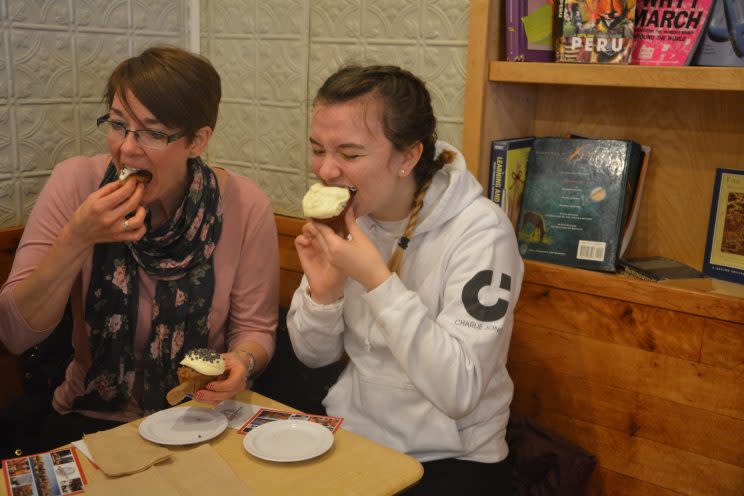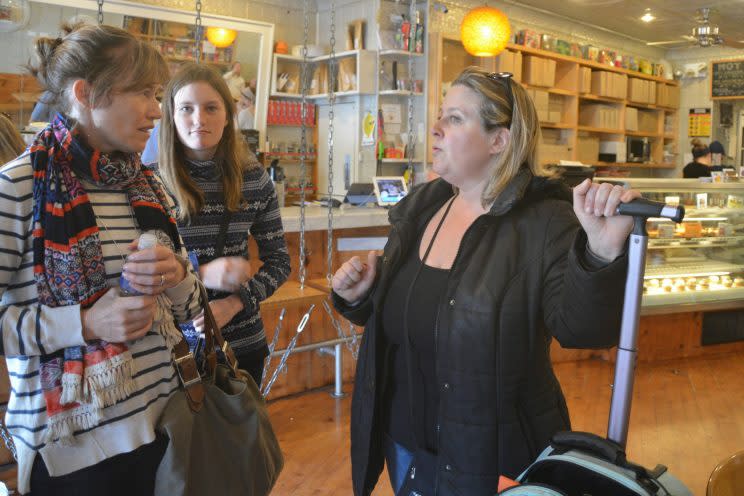How a ‘pay what you wish’ tour company became a $1 million business

It’s summer. Time to pack your stuff and explore the world outside your home.
While traveling can strain your budget, the travel agency Free Tours by Foot offers a price you can definitely afford and has tours across New York, Philadelphia, Berlin and other eight cities. It also turns out to be a $1 million business, though it boosts its bottom line by offering some private tours with set fees.
Pay-What-You-Wish can be a million-dollar business model
“Will it surprise you if I tell you we’re standing on the graveyard now?” Mary H. asked a group of tourists on the northwest corner of Washington Square Park in New York City this past April. In the next two hours of the West Village ghost haunting tour, she showed them historic haunts, telling stories of political intrigue, disease and murder.
Twenty-four tourists from Chicago, Pittsburg, the United Kingdom, France and New York were attracted not only by the novel theme. They learned about Free Tours by Foot from Google by searching “walking tours,” or on TripAdvisor, where it received 5,293 reviews of five stars and ranks first among all outdoor activities in New York. They joined it without charge until the end of the tour, when they could decide how much they wanted to pay.
The pay-what-you-wish model first became popular in Europe among backpackers, who usually travel on a budget. Without any upfront fee, the tour aims to be affordable to everyone. Stephen Pickhardt, a tour guide leading ghost tours in DC, expanded the model to include traditional walking tours and food tours, as well as ghost tours since 2007.

Now the company runs free tours in New York, Philadelphia, Boston, Los Angeles and even Berlin. Without any offices, Pickhardt describes it as an online business where everyone works from home; instead of employees, there are independent contractors—like Mary, who gained the tour guide license after passing a test of 150 questions about history, culture and geography.
“Honestly, when I first started, I didn’t think the pay-what-you-like model is sustainable. I wasn’t sure,” Pickhardt said. He worried people who signed up would simply not show up because there is no upfront fee. Gradually, he identified a plan to limit the number of sign-ups, depending on where and when the tour is. For Mary’s Greenwich tour, Pickhardt said the target number is 18, because the sidewalks are narrow. “We found the guide got paid better if the group was smaller.”
Now the company grosses slightly above $1 million every year, according to Pickhardt. For free tours, tour guides pay a portion of their income, ranging from 10% to 20%, as a commission to the company. The free tours now account for 15% of the company’s total revenue.
The company also operates private tours, for which it charges tourists a booking fee and pays the tour guide at a fixed rate. In New York, for example, a 2-hour private tour costs $125.
Another growing part of the business is online advertising. A self-made SEO (search engine optimization) savant, Pickhardt spent lots of time researching what tourists search for and ask about, from weather to food, and tried to provide the most related and useful information, which attracted a lot of traffic for the website. Then he partnered with other companies by providing links to bus tours and tours in foreign countries. Every click will generate a reward, which he says now contributes to more than one-third of his business, and growing.
Sometimes people pay nothing

Two women left the tour halfway after saying goodbye to Mary, without paying. When the tour ended at St. Mark’s Church-in-the-Bowery, tourists handed her cash and thanked her. Lona Kubik and her husband gave Mary $40. The couple from Pittsburgh said they had taken a dozen of tours with the company, both in the US and Europe. “In New Orleans, we took a regular paid tour first and then three tours from this company. All of them turn out to be better than the regular ones,” Lona said.
“The difference is the tour guides in this company really love what they’re doing. You can feel that passion,” Lona said. “Also, how much they earn directly relates to how well they do the job, so they need to work harder.”
Now, 30-40 tour guides work for the company’s New York branch, providing about 100 tours every week. Lori Pickhardt, Stephen Pickhardt’s sister, is in charge. Previously an elementary school teacher, Lori spends time researching the Greenwich Village neighborhood like she prepared her lesson plans. For the food tour, she would first talk to the restaurants, get approval and then bring the guests in. She says the company does not receive any payment from the stores.
The food tour often attracts a lot of women. People visit six stores and pay a few bucks to sample different delicacies. After tasting some cupcakes at the last stop, a man held a bill under his thumb and shook Lori’s hands. A woman hugged her and put some cash into her bag.
“I never looked how much they gave me,” Lori said. For people who were still relaxing but hadn’t paid, she went over and asked if they need any direction as a reminder. “Some people just forgot,” Lori said. “But you can’t just tell them to pay.”
“Americans are the worst”

Lori finds Europeans are usually more generous than domestic tourists. “Americans are the worst,” she said in a lowered her voice, laughing. She has met tourists who ignored her at the end of the tour. One time, she received a message from a customer who forgot to pay and wanted to mail her the money. She provided her address but never received anything. She says people pay about $10 on average.
That number sounds right to Walter Hoffman, a tour guide working for SANDEMANs New Europe, a Germany-based travel agency claiming it pioneered the free tour model. As a native New Yorker and actor, Hoffman leads tours for different companies between his shooting schedules. At the end of the free SANDEMANs tour in the Financial District last week, he told tourists they could pay whatever they wanted and half of them took out their wallets. Later, he traveled uptown to lead a set-fee tour in Grand Central that costs $20.
“It doesn’t make much difference to me whether it’s prepaid or pay-what-you-wish,” Hoffman said. The reason is simple: for free tours, most money from tourists goes into his own pocket; as for the prepaid tours, the company gets the money and pays him a flat rate.
Camila Dougall, the New York city manager of SANDEMANs, finds most participants in the paid tour come having already taken the free tour. Weather always affects enrollment in the outdoor tours. Some tours are suspended during the winter. Currency exchange rate has an impact as well, which may lead foreign visitors to think twice about the donation when the dollar is stronger.
To the tour guide Mary, that Saturday was much better than the day before, when it suddenly poured with rain and no one showed up for the tour.
“It’s just like being a waitress— you never know what you’ll get. You never walk home with the same amount of money,” Mary said. “But it all balances out in the end.”
Krystal Hu writes about e-commerce and other cool businesses for Yahoo Finance. Follow her @readkrystalhu
Read more:
Think you’re buying on Amazon? It’s actually from Alibaba
How Amazon is eclipsing Walmart’s best efforts to dominate e-commerce
One Quote from Jack Ma sums up a huge shift in China’s economy

